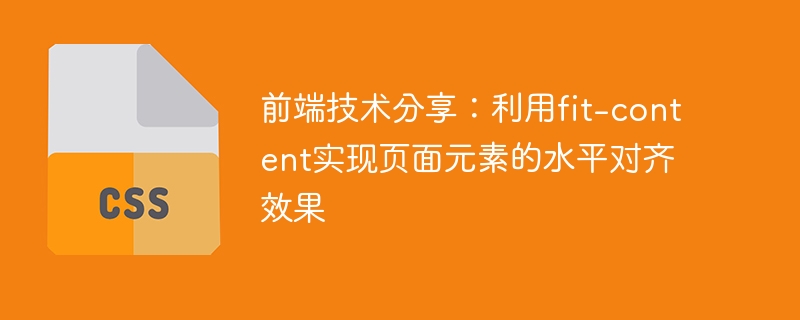Home >Web Front-end >CSS Tutorial >Front-end technology sharing: Use fit-content to achieve horizontal alignment of page elements
Front-end technology sharing: Use fit-content to achieve horizontal alignment of page elements
- PHPzOriginal
- 2023-09-08 12:33:38850browse

Front-end technology sharing: using fit-content to achieve horizontal alignment of page elements
In front-end development, achieving horizontal alignment of page elements is a common requirement. Especially in responsive layouts, we often need to have elements automatically adjust their positions according to the device's screen size to make the page more beautiful and easier to read. In this article, I will share a method of using the CSS attribute fit-content to achieve the horizontal alignment effect of page elements, and provide corresponding code examples.
The CSS attribute fit-content is a powerful attribute that allows an element to automatically adjust its width or height according to the size of its content, thereby achieving adaptive layout. In this article, I will use horizontal alignment as an example to demonstrate how to use the fit-content attribute.
First, we need to define a container element in the HTML document, and then place the child elements that need to be horizontally aligned inside it. For example, we can use the following code to create a container element and place three child elements inside it:
<div class="container"> <div class="box">Element 1</div> <div class="box">Element 2</div> <div class="box">Element 3</div> </div>
Next, we can use CSS styles to define the style of the container element and child elements. In order to achieve the horizontal alignment effect, we can set the display attribute of the container element to flex and set the width of its child elements to fit-content. At the same time, we can also use the margin attribute to adjust the spacing between child elements. For example, we can use the following code to define the style:
.container {
display: flex;
justify-content: center; /* 水平居中 */
}
.box {
width: fit-content;
margin: 0 10px; /* 调整间距 */
}Through the above code, we can achieve the following effect: the child elements of the container element will automatically adjust the width according to the size of its content, and display it in the center, while the child elements There will be a certain spacing between them. In this way, no matter how the width of the page changes, the child elements will always maintain the horizontal alignment effect.
In actual applications, we can customize the styles of container elements and sub-elements as needed, such as modifying fonts, colors, backgrounds, etc. At the same time, we can also add more content to child elements to achieve more complex layout effects.
To summarize, the horizontal alignment effect of page elements can be easily achieved by using the CSS attribute fit-content. By setting the display attribute of the container element to flex and setting the width of its child elements to fit-content, we can let the element automatically adjust its width according to the size of its content and display it in the center. In this way, we can achieve adaptive horizontal alignment effects in responsive layouts.
I hope the sharing of this article can be helpful to front-end developers. If you have any questions or concerns, please feel free to chat with me for discussion. Thanks!
The above is the detailed content of Front-end technology sharing: Use fit-content to achieve horizontal alignment of page elements. For more information, please follow other related articles on the PHP Chinese website!

